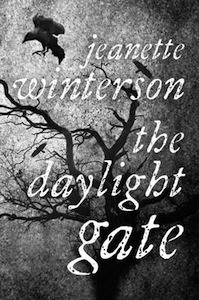
Imagine a modern novelist who feels the breath of history on the back of her neck while writing her latest book. History insists on historical episodes being told with appropriate language. If the book takes place in the immediate aftermath of the Gunpowder Plot of 1605, with characters who grew up during the reign of Queen Elizabeth and watched plays of Shakespeare, then it must follow that the language used in that narrative must be flowery and Elizabethan. And the author, to the best of her ability, must imitate the elaborate linguistic structures of the age she is describing.
That is one way of looking at the historical novel—a way that Jeanette Winterson approaches with suspicion if not outright hostility. In her new book, The Daylight Gate, Winterson’s narrative voice is as fresh and up-to-date as the latest message sent to the Twittersphere by Jennifer Weiner.
The Daylight Gate opens in the Forest of Pendle. The first chapter swiftly pulls us into Lancashire, the “untamed” northern part of England. The culturally deviant and the politically radical alike take refuge there (and so do the perpetrators of the Gunpowder Plot). The book’s narrator describes the forest in tight, spare prose reminiscent of Hemingway.
Those who are born here are branded by Pendle. They share a common mark. There is still a tradition, or a superstition, that a girl-child born in Pendle Forest should be twice baptized; once in church and once in a black pool at the foot of the hill. The hill will know her then. She will be its trophy and its sacrifice. She must make her peace with her birth-right, whatever that means.
The peddler John Law takes a short cut through this forest and he comes across Alizon Device, a witch, who puts a curse on him for his refusal to kiss her on the mouth. As a result, the poor man collapses and provides the thuggish defenders of the English crown with a convenient case for the prosecution of Pendle’s witch coven.
The statesmen’s motto, “Witchery popery popery witchery“, attests to their combined hatred of Britain’s Catholics and witches. Constable Hargreaves and Tom Peeper quickly take the matter to their hands. The Law case helps them satisfy their thirst for sexual and political power. Peeper rapes Sarah Device, one of the women he accuses of being a witch, but before his entourage are done with her the book’s protagonist, Alice Nutter, enters the scene and violently liberates the woman.

Alice is a fascinating, Dorian Gray-like figure whose age nobody knows and whose beauty nobody doubts. Her favorite color is magenta and she is often seen wearing elaborate ornaments of that color. Her “style” is one that Oscar Wilde or Walter Pater, those late-Victorian admirers of the Elizabethan age, would have loved describing in their essays. A favorite of Queen Elizabeth and Shakespeare, Alice made a name for herself when the dye she had prepared in her workshop was discovered by the Queen. Even in the description of this colorful invention, Winterson is unwilling to use flowery language.
Her fortune had come through the invention of a dye; a magenta that held fast in water and that had a curious dark depth to it – like looking into a mirror made of mercury. The Queen had ordered vats of the stuff and Alice had worked for a long time in London, with her own dye-house and warehouse.
Late Victorians wouldn’t be the sole fans of Alice. Virginia Woolf, an Edwardian writer, would surely adore her for her ambiguous sexuality and her Orlando-like role-playing throughout the book. On the face of it Alice is lesbian, but she doesn’t shy away from sexual intercourse with men. The mixture of her radical politics, self-confidence and material wealth make her very attractive in the eyes of even her adversaries. Roger Nowell, the magistrate of Pendle Forest, is among those who admire and scrutinize her position; although he is assigned to investigate witch activity in the area, Nowell, a widower, feels attracted to Alice. There is an obvious discrepancy between Alice’s ambiguous character and the no-BS way that Winterson describes her. Winterson manages to describe this ambiguity lucidly. We sense that Alice is someone we would fall in love with but we are not quite sure why.
Winterson then introduces us to Christopher Southworth, a Jesuit priest and an old friend of Alice, who takes refuge in her room to evade the authorities. Physically, he is in a terrible shape:
When he had been captured after the Gunpowder Plot his torturers had cut his face with a hot iron. They had blinded him by dripping wax into his pinned-back eyeballs. The curious blue of his eyes was due to the elixir that had saved his sight. But nothing could hide the scars.
Southworth has returned to Pendle to save his sister, who is accused of being a Catholic and a conspirator. Winterson takes us on a tour of this politically bleak era, which she often compares to Elizabeth’s. Shakespeare, who appears here in three delightful scenes (in one scene we expect him to sleep with Alice) seems to represent the ethos of the Elizabethan age, while the reign of the fervently anti-papist James I finds its representatives in the bullying prosecutors and informers.
The Daylight Gate is a tastefully gothic tale and a page-turner at heart. Which is not to say that it lacks literary merit. On the contrary, the compulsive state in which one reads the book is a marvelous thing. In no place does Winterson approach her subject lightly; her dramatization of the trial of the Lancashire witches and the politically repressive era that preceded it is a passionate defense of the culture of witchery. The lucidness of the book’s prose attests to Winterson’s desire to appropriate the witch culture for a modern audience, whose cultural affinities with television shows like American Horror Story: Coven are perhaps stronger than their interest in the often impenetrable legal narratives of witch trials under the rule of King James I. The consistently tight prose of the book helps put the focus on the horrific nature of political repression in early seventeenth-century England. The reign of that authoritarian monarch had been so appalling that it doesn’t need the modern imitation of a colorful prose style to show its true nature.




